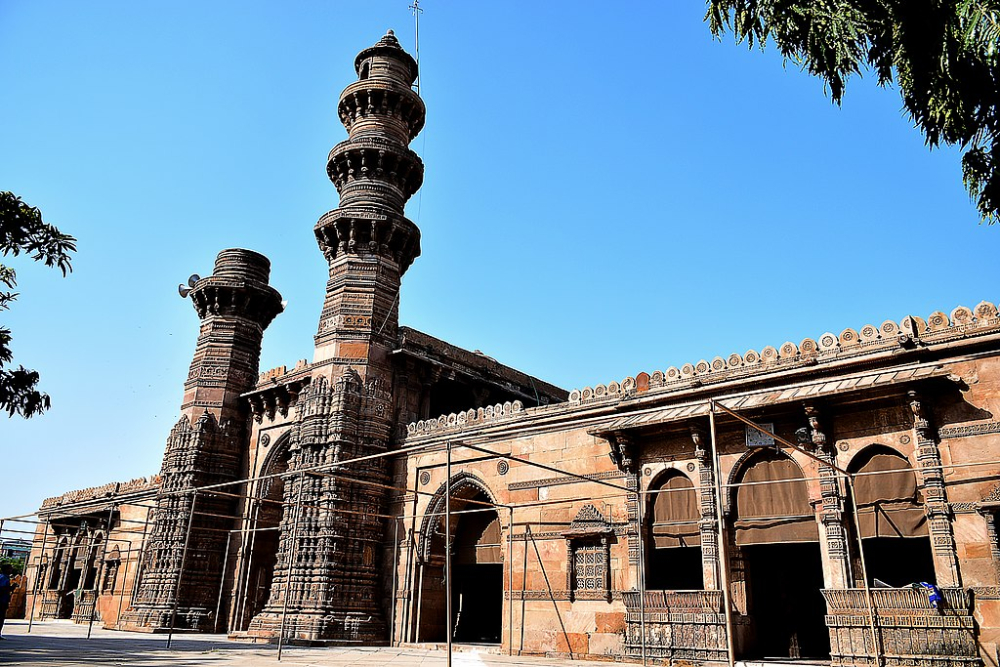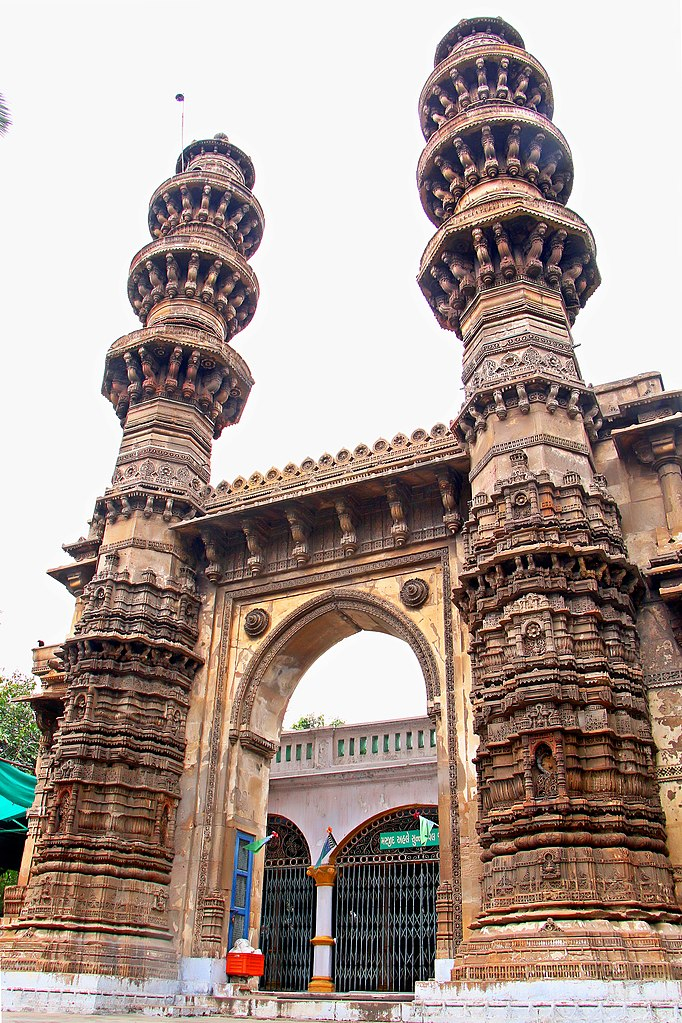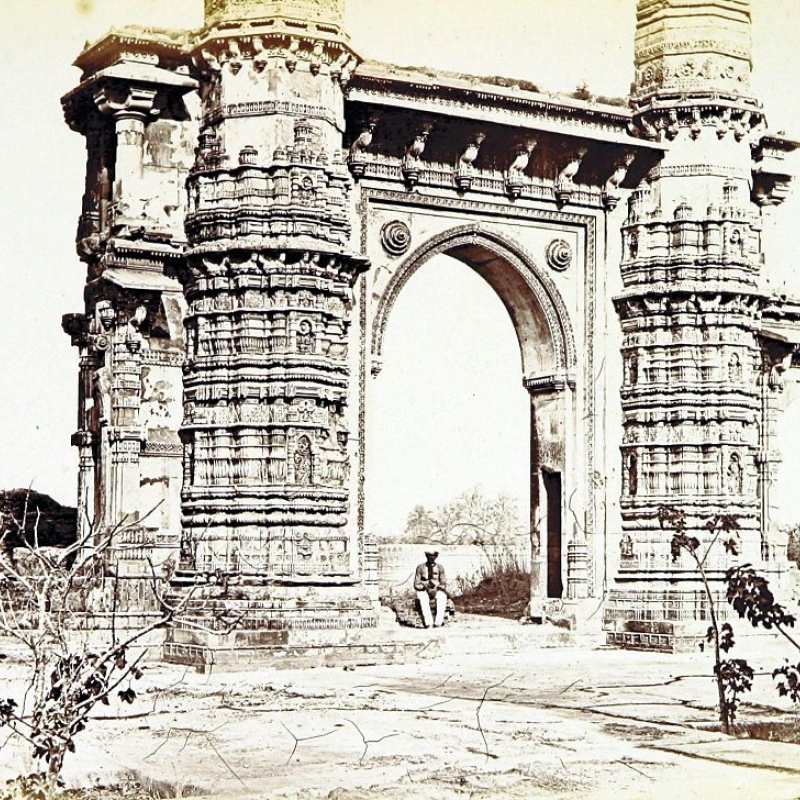The Jhulta Minars, or Shaking Minarets, in Ahmedabad are one of only two of the kind in the world. Having baffled architects, design engineers and tourists alike, we attempt to find out more about these unusual minarets that once belonged to the Sidi Bashir mosque. (Photo courtesy: The British Library [No restrictions])
India has many historical attractions that have an aura of mystery around them. The whispering gallery of the Gol Gumbaz in Vijayapura, Karnataka, for instance, or Lucknow’s Bada Imambara, whose massive three-storey-high central hall has stood for two centuries without any pillars or beams supporting it. Our ancient architects were capable of astonishing feats, and a fine example of their magic is the pair of shaking minarets of Sidi Bashir mosque in the heart of Ahmedabad.
Close to Ahmedabad’s textile centre, Sarangpur, stands the fifteenth–sixteenth-century Sidi Bashir mosque, or what is left of it after the battle between the Marathas and the Khans of the Gujarat Sultanate in 1753. The surviving ruins mainly comprise two minarets and a connecting arched central gateway, which are in dire need of professional restoration and preservation. But, more than the history, the minarets have a particular architectural characteristic that continues to mystify tourists, architects and design engineers alike. These are the Jhulta Minars or Shaking Minarets—when the upper arch of one minaret is shaken with a bit of force, the other begins to vibrate after a few seconds, and the connecting corridor between the two registers a faint shudder. The reason for this vibration is unknown. Visitors were once allowed to climb all the way up through a narrow spiral staircase inside, but public entry was closed in 1981 for the preservation of this architectural wonder.

The three-storeyed minarets, constructed in the Indo-Saracenic style with Rajputana influence, are narrow and not very tall. At around 70 feet, they have delicately carved balconies around each level. There is also beautiful stonework along the base. Curiously, despite their proximity to the railway station, they do not shake when trains pass by. It is believed the minarets were constructed on a cushioning foundation of naturally porous flexible sandstone called itacolumite (found in the Haryana region) to avoid any damage from earthquakes. Author Rana Safvi once wrote that it was the ‘earthquake-resistant construction that gave them their “shaking” character.’[1] Indeed, according to architect James Fergusson, an expert on ancient Indian architecture, these minars are the best surviving examples of shaking minarets dotting Ahmedabad’s skyline. There were others at the Jama Masjid and Bibi-ki-Masjid, which have not survived. Another pair of shaking minarets at the Raj Bibi mosque was apparently dismantled by the British, who wanted to understand the cause of the vibrations, but later could not put them back together.
Related | Sidi Sayyid's Jali, Ahmedabad
Sidi Bashir’s mosque dates back to 1452 AD. The story goes that it was built by an Abyssinian slave named Sidi Bashir during the reign of Sultan Ahmed Shah I (who founded the city of Ahmedabad in 1411). Some others feel that the mosque’s construction and style indicate its construction during the reign of Sultan Mahmud Begada, so it could have been built after 1511 by his courtier Malik Sarang, a Rajput nobleman, who had converted to Islam.
The first known photographs of this stunning mosque are attributed to Robert Melville Grindlay, founder of the erstwhile Grindlays’ Bank. Grindlay, who was only 17 when he arrived in India, served with the Bombay Native Infantry from 1804 to 1820, and made a large collection of sketches and drawings. In Scenery, Costumes and Architecture Chiefly on the Western Side of India (1830), Grindlay wrote about the Sidi Bashir mosque in so many words: ‘The most remarkable circumstance attached to this building is the vibration which is produced in the minarets, or towers, rising from the centre of the building, by a slight exertion of force at the arch in the upper gallery.’[2]
Also read | ‘Culture runs in the Veins of the Community’: An Interview with Vasdev Mohi
With its numerous monuments, Ahmedabad—the old city, in particular—was the first city in India to be declared a UNESCO World Heritage City (in 2017). One of the reasons for this is its history of peaceful coexistence of several religions, some of which has manifested in the harmonious blend of Hindu styles in Islamic buildings, such as mosques and tombs. In History of Indian and Eastern Architecture (1876), Fergusson writes: ‘Of the various forms which the Saracenic architecture assumed in India, that of Ahmedabad may probably be considered the most elegant, as it certainly is the most characteristic of all. No other form is so essentially Indian, and no one tells its tale with the same unmistakable distinctness.’[3]

However, the ASI has been criticised for being negligent with the preservation of many of these monuments. Since 2018 though, they started clearing the space around the Sidi Bashir mosque for better visibility.[4] In 1905, an Archaeological Survey of India (ASI) report had made it clear that the monument was in disrepair—no traces of the mosque remained, other than the minarets and the adjoining tomb of Sidi Bashir that was ‘occupied by faqirs and grass dealers’. Curiously, the report did not refer to the phenomenon of shaking, though it noted that the mosque stood on the waste grounds belonging to the railways, where it still stands, one of the reasons for the lack of restoration. Preservation of the monument is important and urgent because of its rarity—the only other pair of shaking minarets in the world is located in a historical building called Monar Jonban, at Isfahan, Iran.
Also see | Walk-through of the Old City of Ahmedabad
Did You Know
- Henry Cousens, ASI superintendent and photographer, took photographs of the mosque and organised meticulous drawings. These came out as part of The Muhammadan Architecture of Ahmadabad, authored by then ASI director general James Burgess, published in 1905 as the eighth volume of the Archaeological Survey of Western India.
- For his exemplary work on photographing the ancient monuments of western India, Henry Cousens received the Kaiser-i-Hind gold medal, an award given by the Queen mostly to public servants from 1900 until Independence. Among the few non-government recipients were Sarojini Naidu and MK Gandhi, both of whom returned them in 1920.
- Sidi Bashir and Sidi Sayyed (who built the Sidi Sayyed mosque with the famous carving of the ‘tree of life’), are the forerunners of the small, 15,000-strong Sidi community of Indians of African descent in Gujarat.
- The ‘tree of life’ or kalpavriksh, a dominant theme in Hindu, Jain and Buddhist mythologies and found on many of Ahmedabad’s mosques, including Jama Masjid, has become the distinguishing symbol of the city.
This article was also published on The Indian Express.
Notes
[1] Rana Safvi, ‘The Kalpavriksha on Minarets,’ The Hindu, accessed September 23, 2019, https://www.thehindu.com/opinion/columns/the-kalpavriksha-on-minarets/article26544493.ece.
[2] Grindlay, Robert Melville, Scenery, Costumes and Architecture, Chiefly on the Western Side of India (London: Smith, Elter & Co., 1826–1830).
[3] Fergusson, James, History of Indian and Eastern Architecture, Vol. 1 (London: J. Murray, 1876).
[4] ‘Jhulta Minara to Regain its Lost Glory,’ Ahmedabad Mirror, accessed September 23, 2019, https://ahmedabadmirror.indiatimes.com/ahmedabad/others/jhulta-minara-to-regain-its-lost-glory/articleshow/66188063.cms.












